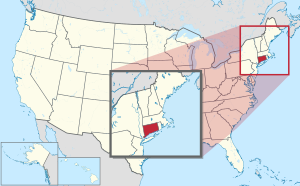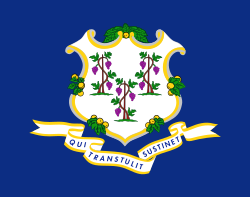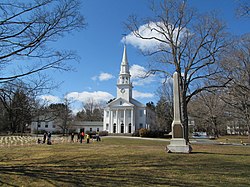Connecticut
Connecticut is a state in the United States. Its capital is Hartford, and its largest city is Bridgeport. It is one of the six states of New England. It borders New York to the west, Massachusetts to the north, Rhode Island to the east, and the Long Island Sound to the south.
Connecticut | |
|---|---|
Nicknames:
| |
Mottoes:
| |
| Anthem: "Yankee Doodle" | |
 Map of the United States with Connecticut highlighted | |
| Country | United States |
| Before statehood | Connecticut Colony |
| Admitted to the Union | January 9, 1788 (5th) |
| Capital | Hartford[1] |
| Largest city | Bridgeport |
| Largest county or equivalent | Fairfield |
| Largest metro and urban areas | New York (combined) Greater Hartford (metro and urban) |
| Government | |
| • Governor | Ned Lamont (D) |
| • Lieutenant Governor | Susan Bysiewicz (D) |
| Legislature | Connecticut General Assembly |
| • Upper house | Connecticut Senate |
| • Lower house | Connecticut House of Representatives |
| Judiciary | Connecticut Supreme Court |
| U.S. senators | Richard Blumenthal (D) Chris Murphy (D) |
| U.S. House delegation | 5 Democrats (list) |
| Area | |
| • Total | 5,018 sq mi (13,023[2] km2) |
| • Land | 4,849 sq mi (12,559 km2) |
| • Water | 698 sq mi (1,809 km2) 12.6% |
| • Rank | 48th |
| Dimensions | |
| • Length | 70 mi (113 km) |
| • Width | 110 mi (177 km) |
| Elevation | 500 ft (150 m) |
| Highest elevation | 2,379 ft (725 m) |
| Lowest elevation | 0 ft (0 m) |
| Population (2020) | |
| • Total | 3,605,944[4] |
| • Rank | 29th |
| • Density | 739/sq mi (285/km2) |
| • Rank | 4th |
| • Median household income | $79,900[5] |
| • Income rank | 6th |
| Demonyms | (colloquial) |
| Language | |
| • Official language | None |
| Time zone | UTC– 05:00 (Eastern) |
| • Summer (DST) | UTC– 04:00 (EDT) |
| USPS abbreviation | CT |
| ISO 3166 code | US-CT |
| Traditional abbreviation | Conn. |
| Latitude | 40°58′ N to 42°03′ N |
| Longitude | 71°47′ W to 73°44′ W |
| Website | portal |
| Connecticut state symbols | |
|---|---|
 | |
 | |
| Living insignia | |
| Bird | American robin |
| Fish | American shad |
| Flower | Mountain laurel |
| Insect | European mantis |
| Mammal | Sperm whale |
| Tree | Charter Oak, a white oak |
| Inanimate insignia | |
| Dance | Square dance |
| Fossil | Dinosaur tracks |
| Mineral | Garnet |
| Motto |
|
| Tartan | Connecticut State Tartan |
| State route marker | |
 | |
| State quarter | |
 Released in 1999 | |
| Lists of United States state symbols | |

Connecticut is called the "Constitution State." In 1639 settlers adopted the "Fundamental Orders," which has been called the first written constitution in history.[9] Its current constitution (Connecticut's third) was adopted in 1965.
Geography
changeConnecticut has forests, rivers, lakes, waterfalls, and a sandy shore.
The Connecticut River cuts through the center of the state. It flows into Long Island Sound, Connecticut's outlet (connection) to the Atlantic Ocean.
Regional variations
changeEven though Connecticut is small, different parts of the state have different landscapes and culture.
Some areas are very rural. For example, the Litchfield Hills in northwestern Connecticut have rolling mountains and horse farms. There are many small towns and rural areas in the northeast and northwest corners of the state.
Connecticut also has industrial cities, located along the coastal highways from the New York border to New Haven, then northwards to Hartford, and farther up the coast near New London.
The state has some very wealthy areas. The southwestern corner of Connecticut, where it touches New York State, includes Greenwich, Stamford, Fairfield, Westport, Wilton, and Darien. Some of the wealthiest residents in the world live in these areas.
Many towns center around a small park, known as a "green" (such as the New Haven Green). Near the green there is often a small white church, a town meeting hall, a tavern, and several colonial houses.
Highest locations
changeThe highest peak in Connecticut is Bear Mountain in Salisbury, in the northwest corner of the state.
The highest point is just east of where Connecticut, Massachusetts, and New York State meet (42° 3' N; 73° 29' W), on the southern slope of Mount Frissell, whose peak lies nearby in Massachusetts.
National Parks
changeThe United States National Park Service maintains several areas in Connecticut. These include the:
- Appalachian National Scenic Trail
- Quinebaug & Shetucket Rivers Valley National Heritage Corridor
- Weir Farm National Historic Site
The Appalachian Trail
changeThe Appalachian Trail runs for about 52 miles through Connecticut, passing through hardwood forests.[10]
At its lowest, the Trail in Connecticut is 260 feet above sea level (just under 80 meters). At its highest, its is nearly half a mile high (2316 feet, or 796 meters).[10]
History
changeThe name "Connecticut" comes from the Mohegan Indian word Quinnehtukqut. This word means Long River Place or Beside the Long Tidal River.
Colonial history
changeIn 1614, a Dutch man named Adriaen Block became the first European explorer to arrive in modern-day Connecticut. After that, Dutch fur traders sailed up the Connecticut River (which they called Versche Rivier). They built a fort near present-day Hartford, which they called House of Hope (Huys de Hoop in Dutch).
The first English settlers arrived in 1633. They were Puritans from Massachusetts, led by the Reverend Thomas Hooker. They founded the Connecticut Colony.
Colonies were also established at Old Saybrook and New Haven, which later became part of Connecticut. Historically important colonial settlements included:
- Windsor (1633)
- Wethersfield (1634)
- Saybrook (1635)
- Hartford (1636)
- New Haven (1638)
- New London (1646)
Because the Dutch were outnumbered by the English settlers, they left their fort in 1654.
Connecticut is the fifth of the original thirteen states.
Changing borders
changeConnecticut's western borders have changed over time.
According to a 1650 agreement with the Dutch, the western boundary of Connecticut ran north from the west side of Greenwich Bay ("provided the said line come not within 10 miles [16 km] of Hudson River").
On the other hand, Connecticut's original Charter in 1662 granted it all the land to the "South Sea" (the Pacific Ocean, which is on the West Coast of the United States).
Connecticut got its current boundaries because:
- Government officials made agreements with New York
- Connecticut fought for control of Westmoreland County during the Pennamite Wars against Pennsylvania
- Congress got involved in setting borders after the Pennamite Wars
- Connecticut had to give up and sell the Western Reserve lands
Related pages
changeReferences
change- ↑ "General Description and Facts". State of Connecticut. Archived from the original on October 16, 2015. Retrieved June 6, 2016.
- ↑ "The Land".
- ↑ 3.0 3.1 "Highest and Lowest Elevations". Elevations and Distances in the United States. United States Geological Survey. 2001. Archived from the original on November 9, 2013. Retrieved October 25, 2015.
- ↑ "US Census Bureau QuickFacts". United States Census Bureau. Retrieved April 30, 2022.
- ↑ "Median Annual Household Income". The US Census Bureau. Archived from the original on January 28, 2020. Retrieved January 28, 2020.
- ↑ "Style Manual". U.S. Government Printing Office. 2000. §5.23. Archived from the original on August 31, 2008.
{{cite journal}}: Cite journal requires|journal=(help) - ↑ "Connecticutian". Merriam-Webster Online. Archived from the original on December 31, 2015. Retrieved October 25, 2015.
- ↑ "State Resident's Names". eReference Desk. Archived from the original on November 17, 2015. Retrieved October 25, 2015.
- ↑ "CT Nicknames - Connecticut State Library - portal.ct.gov". CT.gov. Retrieved 2024-09-29.
- ↑ 10.0 10.1 "Connecticut | Appalachian Trail Conservancy". Appalachian Trail Conservancy |. 2019-12-09. Retrieved 2024-09-29.

